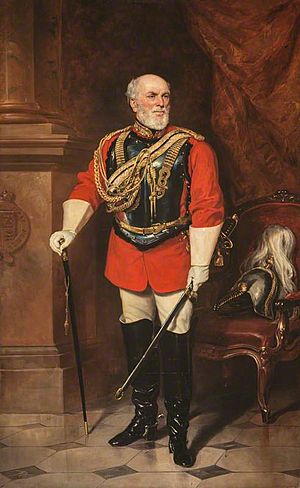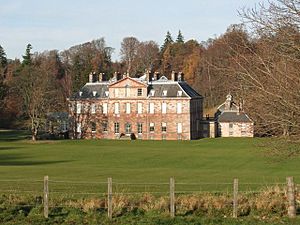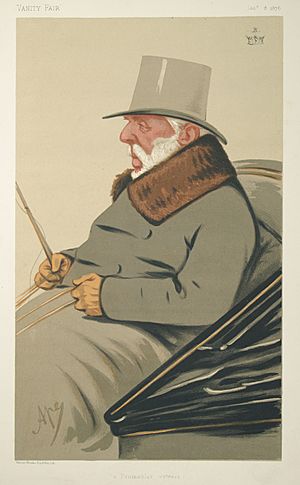George Hay, 8th Marquess of Tweeddale facts for kids
Quick facts for kids
The Marquess of Tweeddale
|
|
|---|---|

The 8th Marquess of Tweeddale
|
|
| Born | 1 February 1787 Bonnington, Scotland |
| Died | 10 October 1876 (aged 89) Yester, Scotland |
| Buried |
Yester, Scotland
|
| Allegiance | |
| Service/ |
|
| Years of service | 1804 – 1848 |
| Rank | Field Marshal |
| Commands held | Madras Army |
| Battles/wars | Peninsular War War of 1812 |
| Awards | Knight of the Order of the Thistle Knight Grand Cross of the Order of the Bath |
George Hay, 8th Marquess of Tweeddale (born February 1, 1787 – died October 10, 1876) was an important British soldier and leader. He became a Field Marshal, which is a very high rank in the army. He fought in major wars like the Peninsular War in Europe and the War of 1812 against America. Later, he became the governor of Madras in India, where he was also the Commander-in-Chief of the army there. He worked hard to make the army strong and disciplined again.
Contents
A Life of Service: Soldier and Leader
George Hay was born at Yester House in Scotland. He was the oldest son of the 7th Marquess of Tweeddale. He went to the Royal High School in Edinburgh. In 1804, when he was just 17, he joined the army as an ensign. Soon after, he became the Marquess of Tweeddale when his father passed away.
Early Military Career and European Battles
George Hay quickly rose through the ranks. He became a lieutenant in 1804. He trained under a famous general, Sir John Moore. In 1807, he joined the Grenadier Guards, a very famous part of the British Army.
He served as a staff officer in the Peninsular War (1807-1814). This war was fought in Spain and Portugal against France. He worked closely with Arthur Wellesley, who later became the Duke of Wellington. In May 1809, Hay was with Wellesley at the Second Battle of Porto. They bravely crossed the Douro river and defeated the French troops. Hay was wounded at the Battle of Bussaco in 1810. He was promoted to major and then to lieutenant colonel after the Battle of Vitoria in 1813.
Fighting in the War of 1812
George Hay also fought in the War of 1812 between Britain and America. He led the 100th Regiment of Foot at the Battle of Chippawa in July 1814. This was a very tough battle. As the British soldiers moved forward, American cannons fired at them. The American army then surrounded the British troops. Hay fought bravely but was captured by the Americans. He became a prisoner of war.
After the war, he returned to Scotland. He worked on improving his family's estate at Yester. He was also involved in Scottish Freemasonry and became a representative peer for Scotland in Parliament. He was made a Knight of the Thistle in 1820. This is a very special award. He continued to be promoted in the army, becoming a major-general in 1837. He even invented a better way to make drainage tiles for farms!
Leading in India and Later Years
In 1842, George Hay returned to public service. He was appointed governor of Madras (now Chennai) in India. At the same time, he became the Commander-in-Chief of the Madras Army. This was a very important job. He worked hard to improve the army's discipline, which had become a bit relaxed.
He retired from active service in 1848 and went back to Scotland. He continued to receive promotions, becoming a full general in 1854. In 1875, he reached the highest rank possible: Field Marshal.
George Hay was known for being a strong and determined person. He once drove a mail coach all the way from London to Haddington without stopping! He passed away on October 10, 1876, at Yester House, following an accident at his home. He was buried in the family vault in Scotland.
Family Life
In 1816, George Hay married Lady Susan Montagu. She was the daughter of the 5th Duke of Manchester. They had a large family with six sons and eight daughters. Some of their children grew up to be important people:
- Lady Susan Georgiana Hay (1817–1853) married the 1st Marquess of Dalhousie.
- Lady Elizabeth (1820–1904) married the 2nd Duke of Wellington.
- Lord Arthur Hay (1824–1878) later became the 9th Marquess of Tweeddale.
- Lord William Montagu Hay (1826–1911) later became the 10th Marquess of Tweeddale.
- Lord John Hay (1827–1916) became a famous admiral in the Royal Navy.
- Lady Emily (1836–1924) married Sir Robert Peel, a well-known politician's son.
Categories




